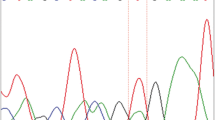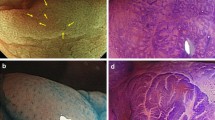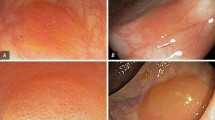Abstract
Sessile serrated adenomas/polyps (SSA/Ps), recently called sessile serrated lesions, have a neoplastic pathway in the large intestine and are treated as lesions with malignant potential. There are a few reports of traditional serrated adenomas in the duodenum but no reports of duodenal SSA/Ps. A 66-year-old man underwent screening upper gastrointestinal endoscopy and was found to have a white elevated lesion in the second portion of the duodenum. Magnifying blue laser imaging showed various sized villous-like structures with dilated crypt openings in the white surface mucosa, similar to a SSA/P. Based on these images, a duodenal adenoma was suspected at the time of endoscopic resection. Pathological findings of the resected specimen showed a saw-tooth structure corresponding to basal crypt dilatation and branching with mucus and positive immunostaining for MUC6 and MUC2, similar to a colonic SSA/P. MUC5AC did not stain the glandular crypt cells. KRAS mutation was detected. Immunohistochemical expression of Annexin A10 was clearly identified in the lesion. Although not all of molecular biological features were satisfied, these findings were similar to a colonic SSA/P which has malignant potential. This is the first report of a duodenal SSA/P which should be considered when evaluating elevated duodenal lesions.




Similar content being viewed by others
References
Park YK, Jeong WJ, Cheon GJ. Slow-growing early adenocarcinoma arising from traditional serrated adenoma in the duodenum. Case Rep Gastroenterol. 2016;10:257–63.
Rubio CA. Traditional serrated adenomas of the upper digestive tract. J Clin Pathol. 2016;69:1–5.
Shinozaki S, Osawa H, Hayashi Y, et al. Linked color imaging for the detection of early gastrointestinal neoplasms. Ther Adv Gastroenterol. 2019;12:1756284819885246.
Owens SR, Chiosea SI, Kuan SF. Selective expression of gastric mucin MUC6 in colonic sessile serrated adenoma but not in hyperplastic polyp aids in morphological diagnosis of serrated polyps. Mod Pathol. 2008;21:660–9.
Sugai T, Eizuka M, Fujita Y, et al. Molecular profiling based on KRAS/BRAF mutation, methylation, and microsatellite statuses in serrated lesions. Dig Dis Sci. 2018;63:2626–38.
Leggett B, Whitehall V. Role of the serrated pathway in colorectal cancer pathogenesis. Gastroenterology. 2010;138:2088–100.
Gonzalo DH, Lai KK, Shadrach B, et al. Gene expression profiling of serrated polyps identifies annexin A10 as a marker of a sessile serrated adenoma/polyp. J Pathol. 2013;230:420–9.
Higuchi T, Sugihara K, Jass JR. Demographic and pathological characteristics of serrated polyps of colorectum. Histopathology. 2005;47:32–40.
Fujimoto D, Muguruma N, Okamoto K, et al. Linked color imaging enhances endoscopic detection of sessile serrated adenoma/polyps. Endosc Int Open. 2018;6:E322-e334.
Fukuda H, Miura Y, Osawa H, et al. Linked color imaging can enhance recognition of early gastric cancer by high color contrast to surrounding gastric intestinal metaplasia. J Gastroenterol. 2019;54:396–406.
Author information
Authors and Affiliations
Corresponding author
Ethics declarations
Conflict of interest
Hiroyuki Osawa has reveived honoraria and grant from the FUJIFILM Corporation and Hironori Yamamoto has a consultant relationship with FUJIFILM Corporation and has received honoraria, grants, and royalties from the company. Other authors have no conflict of interest to disclose.
Human rights
All procedures followed have been performed in accordance with the ethical standards laid down in the 1964 Declaration of Helsinki and its later amendments.
Informed consent
Informed consent was obtained from all patients for being included in the study.
Additional information
Publisher's Note
Springer Nature remains neutral with regard to jurisdictional claims in published maps and institutional affiliations.
Rights and permissions
About this article
Cite this article
Ueno, T., Miura, Y., Osawa, H. et al. Duodenal sessile serrated adenoma/polyp with characteristic endoscopic and pathologic features. Clin J Gastroenterol 14, 531–537 (2021). https://doi.org/10.1007/s12328-021-01358-x
Received:
Accepted:
Published:
Issue Date:
DOI: https://doi.org/10.1007/s12328-021-01358-x




